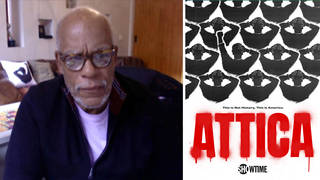
Guests
- Tom Robbinsreporter with The Marshall Project. His investigation, “A Brutal Beating Wakes Attica’s Ghosts: A Prison, Infamous for Bloodshed, Faces a Reckoning as Guards Go on Trial,” was published in collaboration with The New York Times.
- Antonio Yarboughserved 20 years in New York’s notorious Attica prison for a triple murder he did not commit. He was fully exonerated last year and released. He now lives in Queens, NY.
Over four decades after the infamous Attica prison uprising, we look at the savage conditions inside the New York facility where three guards nearly beat a prisoner to death in 2011. The guards were charged for the attack, but just before the trial was to begin, they all have pleaded guilty to a misdemeanor and will not serve jail time. This marks the first time a prison guard in New York has been criminally charged with a nonsexual assault of a prisoner, and it’s also the first time in state history a guard has pleaded guilty to committing an unauthorized violent act against a prisoner while on duty. More than 2,200 men are walled inside Attica, and reports of guards using force against them are up 25 percent in the last four years. The maximum security prison has few security cameras, and prosecutors in the case say this has let guards and prisoners get away with violence. Critics have called for the prison’s closure. We speak to reporter Tom Robbins of The Marshall Project, whose investigation of the guards’ case was published in collaboration with The New York Times; and former Attica prisoner Antonio Yarbough, who served 20 years for a triple murder but was exonerated last year.
Transcript
NERMEEN SHAIKH: More than four decades after the notorious 1971 prison uprising, the upstate New York prison, Attica, is back in the news this week. Three guards at Attica prison have pleaded guilty to brutally beating an inmate, but they themselves will not spend time behind bars. Sergeant Sean Warner, Officer Keith Swack and Officer Matthew Rademacher are accused of breaking both legs of George Williams, as well as his shoulder, his eye socket and his ribs. The beating took place three years ago in front of other prisoners, but it only came to light when Williams had to be taken to a hospital outside Attica to treat his injuries. On Monday, each guard pleaded guilty to a misdemeanor charge of misconduct. In exchange for quitting their jobs, they were spared any jail time. They will also be allowed to keep their pensions. This marks the first time a prison guard in New York has been criminally charged with a nonsexual assault of a prisoner. It’s also the first time in state history a guard has pleaded guilty to committing an unauthorized violent act against a prisoner while on duty.
AMY GOODMAN: More than 2,200 men are walled inside Attica, and reports of guards using force against them are up 25 percent in the last four years. The maximum security prison has few security cameras. Prosecutors in the case say this has let guards and prisoners get away with violence. This is First Assistant District Attorney Vincent Hemming of Wyoming County in New York.
VINCENT HEMMING: I do not fathom why we don’t have cameras in the hallways of Attica, in blocks of Attica. Cameras in Attica will protect both Attica inmates, and it will protect corrections officers. But it will protect the truth more than anything else.
AMY GOODMAN: Meanwhile, others have called for Attica prison to be shut down. This comes as a fourth officer who beat Williams saw his charges dropped after he testified before a grand jury, and is now back to work at his old job.
All of this is detailed in an explosive new investigation headlined “A Brutal Beating Wakes Attica’s Ghosts: A Prison, Infamous for Bloodshed, Faces a Reckoning as Guards Go on Trial.” It was reported by our guest, Tom Robbins, with The Marshall Project, published in collaboration with The New York Times, a big front-page spread on Sunday. The Marshall Project is a nonprofit news outlet focused on criminal justice issues, named after the late Supreme Court Justice Thurgood Marshall.
We’re also joined by Antonio Yarbough, who served 20 years at Attica prison. He was convicted for a triple murder he did not commit, was released last year after he was fully exonerated.
We welcome both of you to Democracy Now!
ANTONIO YARBOUGH: Thank you.
AMY GOODMAN: Tom, let’s begin with you on the Williams case. Just lay it out for us.
TOM ROBBINS: This was an incident in the summer of 2011 that took place on C Block, which, Antonio will tell you, is one of the toughest places in Attica, an already very tough maximum security prison. And guards went to the cell of George Williams, 29-year-old from New Jersey, who was serving a two-to-four-year sentence for robbing a couple of jewelry stores, and took him down the hall to a day room and told him that they were bringing him there for a drug test. And as he was walking into the room, all of a sudden he felt someone clobber him on the ribs on the right side, knocked him to the ground, and then he was all of a sudden assaulted by and pummeled by kicks and batons. And he said somebody jumped on his ankle. He said he opened his eyes at one point and saw an officer taking a step back, aiming a kick at his face, like—he said it was like getting a football punter. I mean, an incredibly brutal beating, that his screams pleading for his life were so loud that inmates two floors below heard him. People I talked to at Attica said, “Yeah, we heard him that night.” About a day later, after he was—he was taken to the solitary, initially, and then he was told—
AMY GOODMAN: Didn’t the guard there say—
TOM ROBBINS: Guard there said, you know, “We’re not going to take him in here like that. We’re going to send you to the infirmary.” And at the infirmary, a nurse said, “We can’t handle him here. You’ve got to go to an outside hospital.” And at the hospital, doctors had to use a plate and six screws to reset one of his legs. He was operated on.
And the thing that happened that was different with this case was that an investigation began. And the investigation was began by the Department of Corrections inspector general, but then state police joined it. And it led, ultimately, to criminal charges filed by the district attorney in Wyoming County, where Attica is located, this small rural community up there near Buffalo. And they charged three—four officers, initially, with gang assault, which is a statute that’s normally used against gangs inside a prison—Bloods and Crips and Latin Kings, whatnot. And they faced up to 25 years on that. There were also charged with felony counts of evidence tampering and misfilings. And the case lingered for about three years.
NERMEEN SHAIKH: And the officers claimed the justification for the beating was what? The suspicion that he had weapons on him?
TOM ROBBINS: Yes, that was the officers’ account.
AMY GOODMAN: But what did prisoners see? I mean, they did this right in front of a number of prisoners, right? Who were—
TOM ROBBINS: There were prisoners located across the hall from the day room, that they were able to see what was going on. And the prisoners described that they jumped on him as soon as he came into the day room. One of them said that he counted as many as 50 kicks and a dozen thwacks from these long batons that the officers carry. And another one said that when he was—George Williams was picked up because he couldn’t walk, he thought he was wearing a red shirt and then realized that he was just drenched in blood. They also saw him brought to the stairs. And when Williams said, “I can’t walk down the stairs, my ankles are broken,” he was shoved from behind. And he was handcuffed at the time, so he fell down.
And at the bottom of the stairs—I’m sorry, this story gets worse. At the bottom of the stairs, someone grabbed his head and smashed it against the wall, and they left him standing there for quite a long time, until—one of the rules in Attica when you’re taken to solitary, which was where they were going to take him next, is that there’s supposed to be a camera crew that records it. It’s supposed to be a separate detail of guards. And he heard them shout, “The cameras are coming.” And then one of the guards picked up what George Williams said was a dirty, wet mop and wiped his face to wipe the blood off it before he was taken to the solitary.
I mean, it’s just—it’s such a gruesome story. And yet, what really struck me in the time that I spent in Attica getting this story was that it’s not surprising to the inmates there. They said it happens all the time.
AMY GOODMAN: So explain how it went from charges, felony charges of this gang assault, to they won’t be serving any time in jail, just this week, this plea bargain.
TOM ROBBINS: There were innumerable hearings and changes in the case over the last three years. Initially, it was thrown out on a technicality. It was re-presented to a new grand jury by the district attorney up there. Finally, ready for trial this past week, and at the last minute, the defendants decided that they would take a deal, that had been on the table, actually, for more than two years, that provided, as you said, for them no jail time in exchange for pleading guilty and quitting their jobs. Essentially, the criminal sanction is very little. When I jumped a turnstile when I was a kid, I got a conditional discharge, as long as I stayed out of trouble for a year. I didn’t lose my job. But the district attorney in Wyoming County was the first one to ever bring this case. It’s not popular amongst the constituents who elect him, so it definitely took some nerve for him to do it.
NERMEEN SHAIKH: And what was George Williams’s reaction to the settlement, so far as you know?
TOM ROBBINS: He’s clearly disappointed that there was no jail time, but I think he’s relieved to put this behind him at this point. I don’t think he was looking forward to being on the stand and being grilled by top defense attorneys, which the union had helped these guards raise funds for them, who were all set to grill George and other inmate witnesses.
AMY GOODMAN: Before we go to the history of Attica, Antonio Yarbough, you’re quoted in Tom’s piece. You were at Attica for how long?
ANTONIO YARBOUGH: Twenty years.
AMY GOODMAN: The full two decades.
ANTONIO YARBOUGH: Two decades, yes.
AMY GOODMAN: Convicted of a triple murder, then fully exonerated and released.
ANTONIO YARBOUGH: Yes, right.
AMY GOODMAN: The C Block that Tom’s describing—
ANTONIO YARBOUGH: Yes.
AMY GOODMAN: —you lived on.
ANTONIO YARBOUGH: No, actually, I lived in D Block, but I also spent time in C Block, A Block. But it depends the type of program that you want to select while you’re there, puts you whatever block that they put you in.
NERMEEN SHAIKH: So what was the D Block that you were in?
ANTONIO YARBOUGH: D Block, I worked in a metal shop. You could work as a porter, or you could work as school porter or something like that. C Block, you know, is more notorious, so nobody really wants to go there. It’s the laundry and the hospital that, you know, you go there and work there, if you want to be in C Block, yeah.
NERMEEN SHAIKH: And could you describe what the conditions were in Attica for those 20 years?
ANTONIO YARBOUGH: Oh, my goodness. It’s like he—like Tom was saying. It’s a horrifying situation, because you wake up not knowing what today is going to bring you. And when I mean “what today is going to bring you,” not what the person that you’re locked next door to, but what the officers, because they have this culture there that, you know, there’s this attitude that everybody that comes from the city—I come from the city, the five boroughs, you know what I’m saying—either they’re slicksters or they’re gang members or, you know, they’re there for what the paper says that they’re there for. And the majority of the time, none of it is true, or half of it is true.
And, you know, so from straight out the gate, they let you know what type of situation that you’re coming into. And they let you know you’re coming into a vile situation, whereas that if you come in there—one of the first speeches I ever got was: “If you eff up,”—excuse me, I don’t want to curse, but—”If you eff up, you’re going to get effed up.” You know, they tell you that right out the gate, you know what I’m saying? You do what our officers tell you to do, you don’t question them, and none of that. You know, and so, you know what you’re getting into, or you know where you’re going into, the moment that you arrive there. You know, they’ll take you, they’ll pull you to the side, outside the presence of other inmates or prisoners, and they surround you with four or five guards, you know what I’m saying? And they give you the threat speech, right out the gate. So, you already know what you’re entering, the moment that you get there.
And so, that’s what happened with me. When I first arrived there, I was 145 pounds, soaking wet. I had never been in trouble, so all this stuff was extremely new to me. But you know the history of Attica from watching, you know, the story about Attica, the riot. So, going there, you’re already afraid. Then, when you get in there, you know, they lay a hammer down, let you know this is what it is, you know what I’m saying? So—
AMY GOODMAN: And, Tom, this history of Attica, that people all over the country might not know, what happened at another September 11th, between September 9th and 13th, 1971?
TOM ROBBINS: Yeah. I mean, one of the things I’m glad about this story is that it’s familiarized a new generation with what was one of the most hideous incidents, I think, in American history, certainly in the last century—an inmate rebellion that took place amid a very restless, political summer in Attica, inmates who were trying to petition the governor at the time for better conditions. They wanted more than one shower a week. They wanted more than one roll of toilet paper a month. They wanted the right to get letters that were sent to them by family members that were written in some language other than English, because the guards were throwing them all away. They wanted better education programs. They were asking for just sort of basic human rights.
And tensions within the prison that summer around those issues, because the governor and his corrections commissioner, Russell Oswald, didn’t respond, eventually spiked. And one small incident, as these things sometimes do, set off a riot on September 9th, that led eventually to—there’s a nexus of the—Antonio could describe it—these four tunnels, as they call it, that crisscross in the middle of this huge institution. They call it Times Square. And inmates who were being brought back from breakfast that morning rioted, and they assaulted a guard who was in charge of the bubble, they call it, right there, controlling the gates, and assaulted him. He was fatally beaten. He died a couple days later. His name was William Quinn. He was the father of three little girls. They then rampaged throughout the rest of the prison, took it over, took some 40 hostages initially. Some were released because of their injuries. But the standoff with the state police went on for the next four days, until Governor Rockefeller decided to send in the troops. And—
AMY GOODMAN: They were negotiating, actually.
TOM ROBBINS: There was a long negotiation.
AMY GOODMAN: And they were asking Governor Rockefeller to come.
TOM ROBBINS: Yes, that was the big demand, was we want Rockefeller to come here. One of the former hostages that I interviewed, a guy named Mike Smith, who still lives just a few miles away from Attica, who had been a guard there, a young first-year guard, talked about how he had been a hostage at the time. And there was a camera crew that was allowed into the yard on Sunday night, before the Monday retaking. And Mike Smith was put in front of the cameras, and he said, “Governor, you need to get your ass here now.” Everyone could tell, apparently—I mean, if you read any of the accounts—Tom Wicker wrote a marvelous book called A Time to Die, that I commend to everyone. Everyone knew that this was going to end terribly unless someone intervened. And sure enough, there had been virtually no planning as to how to do it, we later learned. And—
AMY GOODMAN: I want to go to the clip—
TOM ROBBINS: Sure.
AMY GOODMAN: —of a film called Ghosts of Attica, that—a Lumiere production, which was made for Court TV. This is a story of the man you’re talking about, known as “Big Black,” Frank Smith. He has died since, a prisoner who played a prominent role in the rebellion, and Liz Fink, who served as the lead counsel for the former Attica prisoners.
ATTICA PRISONER 1: Well, just, you know, everywhere you looked around, all you’re seeing was killing and shooting everything they came across.
FRANK ”BIG BLACK” SMITH: People laying all over, and they’re all bleeding and bloody and stuff. You know, so everybody know now that it’s real, that this is it. You know, they’re here now. They’re in the yard now. They got control.
ELIZABETH FINK: State troopers just took their clubs and beat them down the stairs, broke people’s legs, hit them on the tibia and broke tibias. On their back, on their head, in their genitals, on their front, you know, wherever they could hit them, that’s where they beat them.
FRANK ”BIG BLACK” SMITH: I’m telling you, my name is being called: “Where is Big Black? Where is Big Black? Get up, Black! Get up!” And he’s busting me with a [N-word] stick, pickaxe, and got a .38 in his hand. And I gets up. And he—bam! In my side, in my back. And made me run with my hand on my head over to the side. And before I got over there, two, three more correction officers with him now, and everybody’s hitting me.
AMY GOODMAN: That was former Attica prisoner Frank “Big Black” Smith, not to be confused with Mike Smith, who was a guard. Tom Robbins and Antonio Yarbough, I want to thank you for being with us. Should Attica be closed?
TOM ROBBINS: I think there’s such festering fear at that place, that it needs something very radical. Closure would certainly be a good response.
AMY GOODMAN: Antonio?
ANTONIO YARBOUGH: Yes, it should be closed, should be turned into a museum.
AMY GOODMAN: We’re going to do part two of this discussion after the show and post it at democracynow.org, and we’re going to link to the major New York Times piece Tom Robbins has written. He works now with The Marshall Project.












Media Options